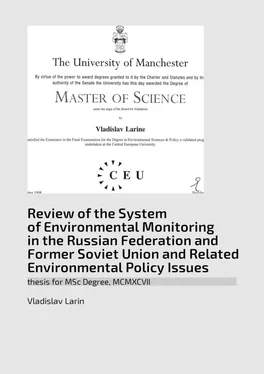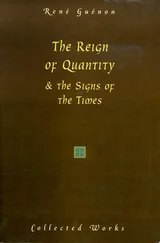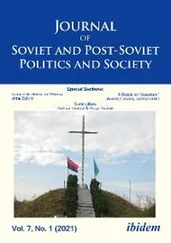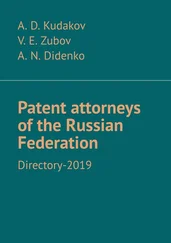Large blocks of environmental information for the territory of the former USSR are located in Moscow, St.-Petersburg, Rostov-na-Donu and Obninsk (small city in Kaluga region about 100km S-W of Moscow). This is data concerning the whole territory of the former USSR. Primary environmental information about the state of the environment is kept in these regional centres. Besides, every organisation collecting this data has its own frameworks for collection and places (cities) for keeping data. In accordance to expert’s predictions, the creating of EGSEM could help to organise all these parts of environmental information in several large regional centres (for details see Chapter 2). Moreover, there will be an evaluation of the degree of reliability of this data and its accessibility for independent researchers.
1.4.4. Accessible places for keeping environmental information
There are several available to independent researchers places where data on the environment is kept. Each of these places for keeping of environmental information is specialised in different types of data collection. Unfortunately, due to financial limitations complete collection of all types of environmental data is not available.
The best libraries with environmental information are:
– library of the Department of Environmental Sciences and Policy, Central European University (Budapest, Hungary) has more completed collection of data and environmental information for the territory of the former USSR, but it is not accessible for researchers from NIS countries because it is located abroad;
– library of the Socio-Ecological Union «EcoLine» (Moscow, Russia) collected by SoES and another NGO «Ecologiya», is not a big collection because of lack of funding;
– library of the Moscow Ecopresscenter (Moscow, Russia) is not complete, but contains the main publications of the GosComGidromet, GosComEcologii and GosComStat.
1.5. How to use collected environmental information
Environmental information collected by the official organisations both in Soviet times and at present was used for making of important political decisions about location of new industries and for adoption of state’s environmental policy.
In Soviet times, all important decisions were adopted by a narrow group of experts without discussion with independent researchers and without public participation. As a result of this policy serious mistakes and wide-scale environmental disasters happened very often. At present the process of decision-making has a more democratic character, but it also has problems linked to the communist past of most modern leaders. Adaptation of the new methods for decision making is still difficult.
Among the last achievements in the sphere of publication and application of environmental information collected by the governmental organisations the Annual Reports on the State of the Environment in Russian Federation prepared by the State Committee of the Russian Federation for Protection of the Environment (GosComEcologii) should be mentioned.
The first Soviet report from this series for the territory of the USSR was prepared in 1988. A more completed report was prepared for the Conference in Rio-de-Janeiro in 1992, but in that time the USSR was collapsing and this report appeared as the first State’s Report on the State of the Environment of the Russian Federation for 1991 (Gosudarstvenniy Doklad…, 1992) and as separate reports several other states of CIS. For the appearance of this report a remarkable role played the Counsellor for Ecology and Environment Protection Policy of the President of Russian Federation Alexey V. Yablokov.
The last report of this series was for 1996. From year to year reports become bigger by volume and by diversity of examined problems. It should be noted that the possibility for acquaintance with the completed versions of the Report is difficult for the public yet because it is printed in limited copies and is not for sale. Several «green» newspapers publish short versions of the Report. Moreover, environmental researchers and journalists can visit the GosComEcologii to study the complete text of the Annual State’s Report on the State of Environment of the Russian Federation.
Role and Place of the Main Environmental Organisations in the System for Collection of Environmental Information
2.1. System for collection of environmental information in the Russian Federation
Before the collapse of the USSR the Russian Federation had main role in the system of environmental monitoring and collection of data on the state of the environment for all the territory of the country. In Moscow, St.-Petersburg, Rostov-na-Donu, Obninsk and several others centres, situated in the Russian Federation, all data of monitoring, more or less processed, was accumulated.
Russian research and methodological institutions were the leading in the development of methods for proper and correct collection of primary data for all republics of the former Soviet Union. As an example, could be named the last edition of the «Manual Instruction for the Control of Atmospherics Pollution RD 52.04.186—89» (Rukovodstvo po kontrolu…, 1991), prepared under the supervision of the State Committee of the USSR for Hydrometeorology (Federal Service for Hydrometeorology and Environmental Monitoring of the Russian Federation at present) and Ministry of Health of the USSR.
The Russian system for collection of environmental information was affected to lesser degree after the collapse of the USSR in comparison with similar systems of the other NIS countries. In spite of the financial and structural crisis collecting of data on the state of environment did not stop, moreover in some cases it even increased (Tsaturov, pers.comm.).
The centralised system existing in the USSR enforced republics to send information to the Center – Moscow and several main centres – not only for keeping of data but also for data processing. Therefore, almost all data, collected during the history of the USSR is stored in several main organisations. Most of the data on the state of environment and its influence on public health, presented in annual reports of the RosGidromet, GosComStat, MinZdrav, etc. could be founded in Moscow, St.-Petersburg, Rostov-na-Donu and Obninsk.
The former Soviet republics kept information which was only on the state of environment on their respective territories. In many Newly Independent States the volume of data collecting decreased as a result of political, financial and other reasons. Data on the state of the environment after 1991 in the whole volume could be founded only in maim environmental organisations NIS, located in Moscow – if it is collected, processed and published.
Main parts of the data collected before the collapse of the USSR could be found in Moscow or in several regional centres, specialised in collecting special environmental information. For example, in the system of RosGidromet St.-Petersburg specialised in information on the state of air pollution (monitoring, processing of collected primary data, methodical support of all these actions). Rostov-na-Donu specialised in information on the state of fresh water pollution (monitoring, processing of collected data, methodical support). In Moscow is located the main office and several specialised departments (for monitoring of sea pollution, soil pollution, radioactive contamination, etc.). In Obninsk is located the International Center for data collection all meteorological information and data on environmental monitoring is kept (for details see Chapter 2.3.).
Within the system of GosComStat all environmental information, collected in the regions, comes to the main office in Moscow, where it is used for of preparation reference books and data collections (for details see Chapter 2.4.).
Читать дальше












